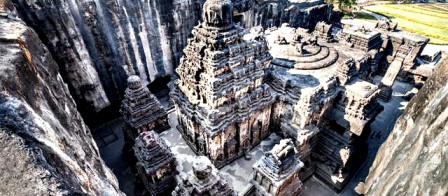Chalukya Dynasty – History Study Notes & Stuff
The Chalukyas ruled the region of the western Deccan from 543 to 755 AD Ruled until. Pulakeshin I was the founder of the Chalukya dynasty. They remained a major power in the Deccan during the sixth to eighth century AD.
Pulakeshin I established a small kingdom in the western Deccan and its capital was Vatapi or Badami (located in present day Bijapur district of Karnataka). He also performed Ashwamedha sacrifice.
Pulakeshin II (608-642 AD)
Pulakeshin II is praised, in the Aihole inscription composed in Sanskrit by his court poet Ravikirti. He is said to have overthrown the Kadambas at Banavasi, and forced the Ganga of Mysore to accept his intimacy. Pulakeshin II made his advance check in the Deccan after defeating Harshavardhana's army at Narmada.
He fought twice with the Pallavas, in his first campaign, he defeated King Mahendravarman I and defeated the Krishna-Godavari region (later known as Vengi) from him.
He fought a second battle with the Pallava king Narasimhavarman II. Narasimhavarman I defeated him near Kanchi and captured the Chalukya capital Vatapi.
In the reign of Pulakeshin II, the Chinese scholar Hiuen Tsang visited the Chalukya kingdom.
Vikramaditya II: He attacked Kanchi, the capital of the Pallavas thrice and defeated the Pallava dynasty completely.
Kirtivarman II: He was the last Chalukya ruler and was defeated by Dantidurga, the founder of the Rashtrakuta dynasty.
Administration under Chalukya Dynasty:
The Chalukya kingdom, unlike the 'Pallavas and Cholas', was a highly centralized administration and the village did not have autonomy.
The Chalukyas had great maritime power, Pulakeshin II had 100 ships with a small standing army.
The Chalukyas were Brahmanical Hindus, giving importance to Vedic rites and rituals. Whereas, they also respected other religions.
Hiuen Tsang mentions the decline of Buddhism in the western Deccan and the advancement of Jainism. Ravikirti, the court poet of Pulakeshin II, was a Jain who wrote the Aihole inscription.
Chalukya Dynasty Art and Architecture:
The Chalukya developed the Vesara style and reached its peak under 'Rashtrakuta and Hoysala'. Strutural temples at Aihole, Badami, Pattadakal. Cave temple architecture is exemplified in Ajanta, Ellora, Nasik.
Chalukyan painting - Badami cave temple and Ajanta caves.
Aihole temples of Chalukya Dynasty:
- Lad Khan temple (Surya Temple) with low, pillared hall with flat roof.
- Durga temple resembling a Buddhist Chaitya.
- Huchimalligudi temple
- Jain temple/ Jinendra at Meguti by Ravikirti.
Badami temples of Chalukya Dynasty:
Muktheeswara temple and Melagulti Sivalaya. There are four rock-cut temples at Badami.
Pattadakal temples of Chalukya Dynasty:
There are total ten temples in Pattadakal.
- Four temples in Northern Nagara style - Papanatha temple
- Six temples in Dravidian style – Sangamesvara temple, Virupaksha temple( it is like Kailashnath temple of Kanchipuram).
P.S. In the seventh century, a large number of Zoroastrians were forcibly converted by Arab armies invading Persia, and in the early eighth century, many fled the sea in western Chalukya India and were given asylum. The descendants of these Zoroastrians are members of the present Parsi community.
We hope that this short notes about Chalukya Dynasty is useful for your quick revision. If you want us to add any more details to this article, please do let us know in the comments below.








0 Comments